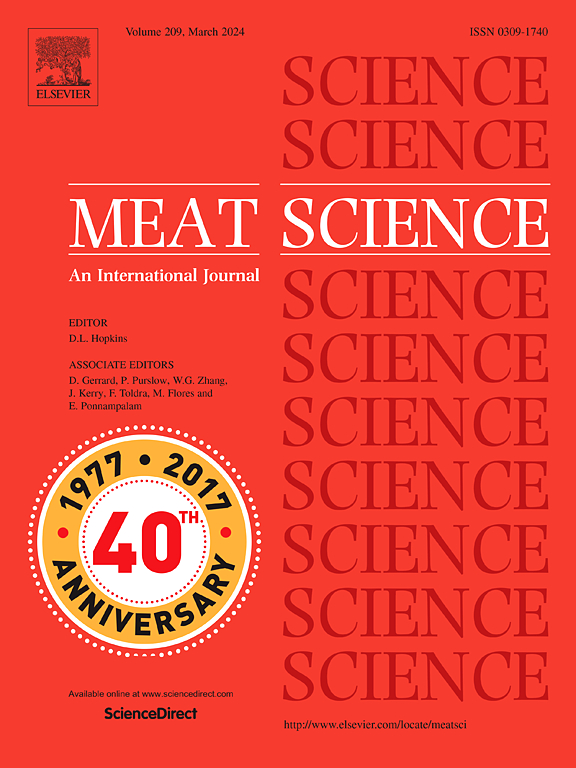The shelf-life of vacuum-packed pork primals at different storage temperatures
IF 7.1
1区 农林科学
Q1 Agricultural and Biological Sciences
引用次数: 0
Abstract
There is little published data on the current shelf-life of commercial vacuum packed (VP) pork at different storage temperatures. This can make it challenging for processors to assure premium quality products throughout different supply chains. The aim of this study was to systematically determine the quality shelf-life of VP pork produced by two commercial establishments at four different temperatures (from −0.5 °C to 10 °C). Different VP pork products (rind-on and rindless leg and shoulder) were analysed for changes in bacterial counts (total viable count and lactic acid bacteria), pH, and sensory properties (‘persistent’ colour and odour) throughout storage. Both rates of TVC increase and odour change were strongly temperature dependent, indicating the potential to predict as a function of temperature. However, shoulder exhibited faster rates of bacterial growth and quality loss compared to leg products, possibly due to the higher pH of shoulder (pH 5.67 vs 6.28). Additional studies are required to evaluate these observations. Furthermore, despite having similar growth rates, rind-on products had a faster rate of quality loss compared to rindless. This was likely due to rind-on products typically not having a lag phase before bacterial growth commenced. Therefore, growth and accumulation of spoilage metabolites would start sooner on rind-on products compared to rindless, where a lag phase was observed. The results of this study highlight the quality shelf-life of VP pork at different storage temperatures, and the feasibility to develop models for shelf-life prediction. Such models can be used as a decision support tool for better supply chain management.
真空包装猪肉原料在不同贮存温度下的保质期
目前,关于不同储存温度下商业真空包装(VP)猪肉的保质期的公开数据很少。这使得加工商在不同的供应链中确保优质产品变得具有挑战性。本研究的目的是系统地确定两家商业机构在四种不同温度(从- 0.5°C到10°C)下生产的VP猪肉的质量保质期。分析了不同VP猪肉产品(带皮和不带皮的猪腿和猪肩)在整个储存过程中细菌计数(总活菌数和乳酸菌)、pH值和感官特性(“持久”的颜色和气味)的变化。TVC增加和气味变化的速率都强烈依赖于温度,这表明了作为温度函数的预测潜力。然而,与腿部产品相比,肩部表现出更快的细菌生长速度和质量损失,可能是由于肩部的pH值较高(pH值5.67 vs 6.28)。需要进一步的研究来评价这些观察结果。此外,尽管有相似的增长率,但与无壳产品相比,有壳产品的质量损失率更快。这可能是由于在细菌生长开始之前,直接使用的产品通常没有滞后期。因此,与无皮产品相比,有皮产品的腐败代谢物的生长和积累会更快开始,在无皮产品中观察到滞后期。本研究结果突出了VP猪肉在不同储存温度下的优质货架期,以及建立货架期预测模型的可行性。这些模型可以作为更好的供应链管理的决策支持工具。
本文章由计算机程序翻译,如有差异,请以英文原文为准。
求助全文
约1分钟内获得全文
求助全文
来源期刊

Meat Science
工程技术-食品科技
CiteScore
12.60
自引率
9.90%
发文量
282
审稿时长
60 days
期刊介绍:
The aim of Meat Science is to serve as a suitable platform for the dissemination of interdisciplinary and international knowledge on all factors influencing the properties of meat. While the journal primarily focuses on the flesh of mammals, contributions related to poultry will be considered if they enhance the overall understanding of the relationship between muscle nature and meat quality post mortem. Additionally, papers on large birds (e.g., emus, ostriches) as well as wild-captured mammals and crocodiles will be welcomed.
 求助内容:
求助内容: 应助结果提醒方式:
应助结果提醒方式:


